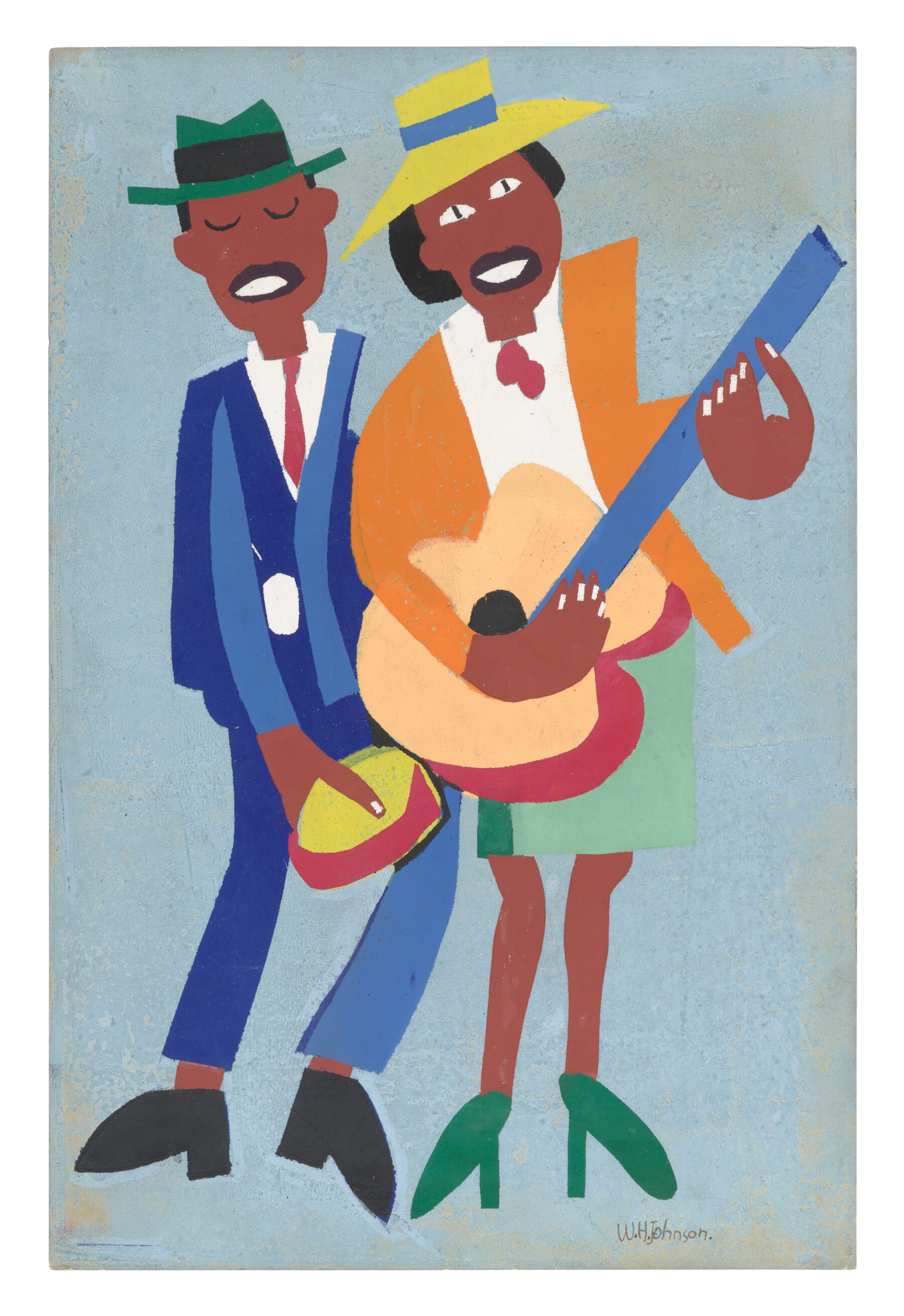William H. Johnson
William H. Johnson was one of the most prolific black artists of the Harlem Renaissance, whose spare, brightly colored modernistic scenes capture the spirit of the period. Born in Florence, Carolina, Johnson showed an early aptitude for art, having aspirations to become a newspaper cartoonist. In 1918, Johnson left his rural upbringing to pursue a new life in New York, joining an uncle in Harlem. The exodus of black families from the segregated South to the industrial cities of the North was known as the Great Migration, and it would have reverberating effects in American art and culture for generations.
In Harlem, Johnson worked numerous jobs in the service industry in order to earn enough money to attend theSchool of the National Academy of Design. Johnson studied with the artist and instructor Charles W. Hawthorne, renowned for his establishment of the Cape Cod in Provincetown, Massachusetts. Hawthorne was an influential teacher, encouraging Johnson to explore color in his early figurative paintings. Johnson earned numerous prizes and accolades for his work, however he did not secure a desired scholarship to travel abroad. Hawthorne championed for the young artist and financed his trip to Europe in 1926, where he worked in Paris, Moret-sur-Loing, and Cagnes-sur-Mer. Johnson studied European modernism and painted expressionistic landscapes of France using vibrant colors and thickbrushstrokes. In 1930, Johnson married the Danish artist Holcha Krake. The two spent most of the decade in Scandinavia, where Johnson developed a great interest in folk art and primitivism. He carried primitive style into his own art for the remainder of his career.
In 1938, Johnson left Europe at the outbreak of World War II and settled in Greenwich Village. He found employment as an instructor at the Harlem Community Art Center (HCAC), originally established by the sculptor Augusta Savage butrun by the Works Progress Administration during the Depression. The Center was a vital resource for the Harlem community, fostering the careers of Johnson, as well as artists Charles Alston, Henry Bannarn, Selma Burke, Gwendolyn Jacob Lawrence and many others.
In New York, Johnson explored new subjects and mediums, including screen printing, a technique typically used forcommercial art but repurposed by fine artists at the Center. Johnson was accustomed to wood block prints during his Expressionist period, but embraced the new technique for itsexuberance in color. Screen printing allowed Johnson to explore simplified forms, flat planes of brightcolor, and inexpensive opaque inks. Johnson simultaneously created paintings and screen prints during thisperiod, using subjects related to the black experience. Johnson depicted everyday scenes from Harlem — street musicians and dancers, agrarian Southern life, black American heroes, black soldiers, and religious imagery.
The present work, Blind Singer is a silkscreen print that depicts a pair of fashionable street musicianscommonly seen on the streets of New York during Johnson’s era. The subject may represent singers such as Blind Boy Fuller, Sister Rosetta Tharpe, or the Reverend Gary Davis. These musicians hailed from the South,and their music made the blues tradition familiar to mainstream audiences. At left, a blind male singer wears adapper navy suit and holds a tambourine. He is accompanied by a woman guitarist, smiling brightly at the viewer. Johnson used spare forms and bright, saturated colors to convey the exuberance of the performance and show hissophisticated style of modernism.
Johnson experienced commercial and critical success during the 1940s, however his physical and mental health declined following the death of his wife in 1944. Johnson left for Denmark in 1946 to be with his wife’s family. However, Johnson’s immense grief and his own untreated medical issues caused a mental breakdown and subsequent institutionalization. In a hospital in Oslo, he was diagnosed with syphilis, which impaired both mental and motor function. Johnson was forced to return to New York, where heentered the Central Islip State Hospital on Long Island. His belongings, including his artwork, were placed in storage. Johnson spent the last twenty-three years of his life at the hospital.
In 1956, Johnson’s artwork was almost destroyed when his caretaker declared him unable to pay further storagefees. Helen Harriton, Mary Beattie Brady, and others arranged with the court to have Johnson’s belongings delivered to the Harmon Foundation with unconditional rights over all works. The foundation would use theworks to advance interracial understanding and support African American achievements in the fine arts. In1967, the Harmon Foundation gave more than 1,000 paintings, watercolors, and prints by Johnson to theSmithsonian American Art Museum. SAAM now has the largest collection of the artists paintings andscreen prints and has organized many exhibitions including the 1991 blockbuster retrospective, Homecoming: The Art and life of William H. Johnson.
William H. Johnson
Blind Singers, 1940
Silkscreen on paper
17 1/8″ x 11 1/8″
Signed lower right
Provenance
Collection of Mary Beattie Brady, Pawling, NY
Michael Rosenfeld Gallery, New York
Private Collection, California, acquired from the above in 2005

